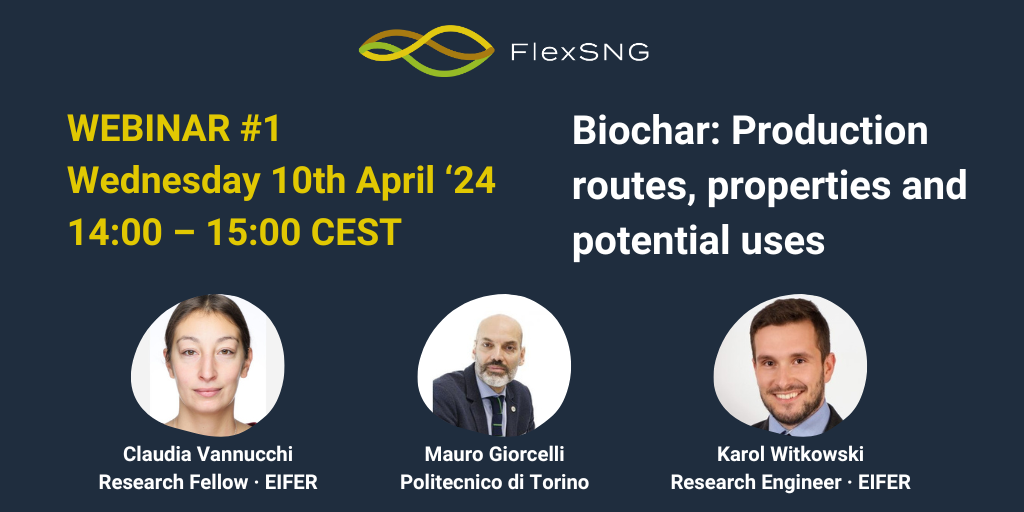If you missed the first episode of the FlexSNG webinar series, or you would like to watch it again, the full recording is available here: https://youtu.be/5E_3_ofMlek?si=gu81XyU972uLbp28
The webinar welcomed more than 100 guests online and received many questions from an active audience.
A recap of all the questions asked can be found in the table below:
| Question | Answer |
| Have to select feedstock according to th exepected use of the biochar? | I think it could be very helpful to select a feedstock that will best fit the future biochar application (if available before) |
| Have to select feedstock according to th exepected use of the biochar? | For example, you could choose the feedstock depending on ash content, moisture content, volatile content, and the presence or absence of harmful chemicals. some types of bio-waste for certain applications contain harmful chemicals that can be found in the biochar as well that impedes its use as soil amendment for examples |
| Is there any analisis on pretreatment according biomass? green waste? | yes, there is a series of pre-treatment processes that can be used according to the type of biomass, it varies a lot from one to the other, but usually at least a drying step is needed for pyrolysis and gasification |
| If biochar is mainly produced from wood residues, would a competition on use could appear ? with wood-energy for example ? | that´s definitely the case, I think that is the hardest point of all of the biomass roadmaps/scenarios (understanding what should be prioritized: biofuels, biochar, etc…) |
| is it more valuable to maximize the biochar production or the syngas production? | A concept was shown in the presentation. |
| All applications aren’t relevant for carbon sequestration? when Biochar becomes a waste with contaminants, what we do? New pyrolysis and separation of carbon and contaminant? | thank you for the question. Biochar “contaminated” for one application might be interesting for another application instead. Example: a biochar polluted with heavy metals is not suitable to be put in soil but is useful for example in a composite if you want to increase its electrical conductivity. Nothing in nature is waste. |
| What about comparative between active carbon imported VS biochar on purification? Equivalent adsorption or as to be activated? or coupled with another tools? or mixed active carbon+Biochar? Ability to adsorb PFAS? | Thank you for the many questions. I can generically tell you that in many applications biochar is used not as a total but partial replacement of the previous carbonaceous material. So this technique can be applied here as well. Every biochar is different, there is no single type of biochar, so you have to engineer the biochar for the required application. |
| Thank you for your presentation. For production what is the specific energy consumption of biochar? I supposed that biochar has a life or operation, so what is possible to use the waste of biochar after this operation time? | Thank you for the question. Biochar can also be recovered after its use. For example, biochar used in a filter, once saturated with filtered material, can become a “functionalized” biochar useful for another aplication without needing to be cleaned up. |
| Do we have any ideas of capturing the biogenic CO2 from the pyrogas combustion (in cases where we have energy recovery) to then use the Bio CO2 for other applications like SAF or industries? | This is another topic, we cannot really cover it here. It can be done, probably the oxycombustion can be very interesting option here, to ease the CO2 capture. Then either e-biomethanol or e-bio-FT-liquids. So far TRL is not that high. |
| Thank you for the presentation, Mauro. Is it possible to get carbon credits through the use of biochar in various fields, such as composites, aside from its utilization as a soil improver? | Thank you for the question. Carbon credits for now are only applicable to biochar that is applied to soil, so for agricultural uses. In Europe we are working with EBI to demonstrate the permance of biochar in other sectors as well, for example in cement. When the permanence of biochar is also demonstrated in cement then carbon credits can also be created by putting biochar in cement. |
| Thank you for the presentation, Mauro. Is it possible to get carbon credits through the use of biochar in various fields, such as composites, aside from its utilization as a soil improver? | carbon credit and export/import product, would be a risk to loose the core principle of why to do biochar. Locally |
| How do you make biomethane in a gasifier? Do you do reformation of the Syngas? | please join our 3rd webinar on 22nd May for more info on this topic |
| which is the best biomass to obtain optimal biochar yield? | I guess the question would be more, what biomass are locally unused and able to be convert in biochar. The optimal would be wood residues, already quite used in other value chain. |
| Karol, which kind of biomass did you use regarding data you showed? | Bark, wood and straw |


